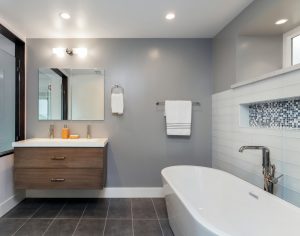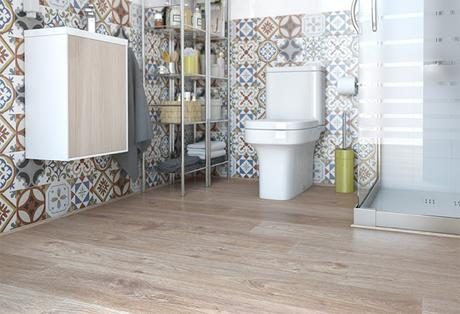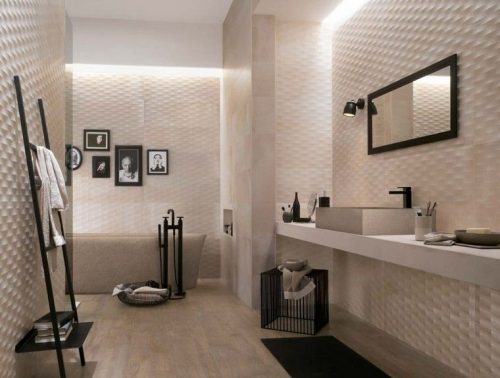3 Bathroom Tile Styles That You Can Combine

Often we go with a single tile design for our bathroom and we move onto the next thing. We only look for a discreet, simple, practical result that’s easy to clean and maintain.
However, we tend to forget that we can create striking and original designs when we use different styles of tile. All we have to do is combine them to create balanced and harmonious compositions.
In the following sections, we’ll give you three different ways to combine bathroom tile styles.
1. Hydraulic tile
First, we want to explain what these tiles look like. They’re made of pigmented cement in different colors. They’re manufactured with a hydraulic press, hence the name.
They originated in France at the end of the 19th century. They quickly spread around the world because of their beauty. Antonio Gaudi introduced them to Spain, and people considered them to be very modern at the time.

Hydraulic tiles / paperblog.com
These tiles call our attention due to their busy, varied designs. Some examples are mosaics with Moroccan or Mudejar inspiration, geometric motifs, and plants. They’re very decorative, as well as strong and solid.
What’s most common is to find them in the same or similar design when they’re in one room together. You can also alternate them with smooth tiles in light tones, or in white.
However, you can combine them following patchwork guidelines. Textile crafts use this technique very frequently. This technique consists of combining different pieces of cloth to form a single garment. We’re doing the same thing here, just with tiles.
If you want to install hydraulic tiles into your bathroom, you’ll have to follow some guidelines so that your bathroom doesn’t become overwhelmed by how busy they are. For example, you may want to choose them in the same pattern but with different colors, or vice versa.
You can also place tiles with the same design in any space. When you do this the tiles around the perimeter can be different from the rest.
Whatever you do, hydraulic tiles give a spectacular result. People usually use them on floors, rather than walls.
2. Bathroom tiles with indentations
These tiles with indentations are a novelty. Their designs are always complex, and they represent real pieces of art.
We don’t only see tiles like these in bathrooms. It’s also common for us to see grooved or indented tiles in kitchens. In both cases, you would see them on the walls rather than the floors.
Depending on the complexity of the design, you can combine these tiles with simpler ones that only have one color such as white or silver.

Indented tiles / pinterest.com
You can also place them halfway up the wall, leaving the upper part painted. This may be slightly more practical. Or instead of painting the upper half you can incorporate a different type of smooth tile.
By using these tiles you create a feeling of dynamism or movement. Another possibility if you want to use this type of tile is to choose a simple tile for the entire room except for a border that runs through the entire space. This type of contrast is very pleasing to the eye.
If you’re using light and inconspicuous colors, you should consider playing with different textures.
3. Tiles of different sizes, shapes, and colors
In this last section, we want to give you one more option. In the previous cases, all the walls and floors were covered, for the most part, with tiles of the same design. However, what you should think about doing is using different types of tiles in your bathroom.
In this way, you can perfectly define different areas of the bathroom. One type of tile would define the shower area, another where your sink is. Doing this would create much more visual, clear, and orderly contrast.
For this, you can use tiles of different colors as long as they’re complimentary and not too bright. Another option is to choose one type of tile for the floor and another for the walls.

To create even more contrast, you can choose tiles in different sizes and shapes. For example: hexagonal floor tiles and rectangular or square tiles (the most common tiles) for the walls. If they’re small and rectangular, you can place them in the shape of a spike.
Try to play with the contrasts between smooth and patterned tiles. We know you’ll love the result.
Conclusion
As you can see, we have all the potential for creating really eye-catching designs for our bathrooms. We can also apply these principles of design to our kitchens. Consider all of the possibilities. You just have to combine different styles properly without overloading the environment so that it feels comfortable and natural.
Often we go with a single tile design for our bathroom and we move onto the next thing. We only look for a discreet, simple, practical result that’s easy to clean and maintain.
However, we tend to forget that we can create striking and original designs when we use different styles of tile. All we have to do is combine them to create balanced and harmonious compositions.
In the following sections, we’ll give you three different ways to combine bathroom tile styles.
1. Hydraulic tile
First, we want to explain what these tiles look like. They’re made of pigmented cement in different colors. They’re manufactured with a hydraulic press, hence the name.
They originated in France at the end of the 19th century. They quickly spread around the world because of their beauty. Antonio Gaudi introduced them to Spain, and people considered them to be very modern at the time.

Hydraulic tiles / paperblog.com
These tiles call our attention due to their busy, varied designs. Some examples are mosaics with Moroccan or Mudejar inspiration, geometric motifs, and plants. They’re very decorative, as well as strong and solid.
What’s most common is to find them in the same or similar design when they’re in one room together. You can also alternate them with smooth tiles in light tones, or in white.
However, you can combine them following patchwork guidelines. Textile crafts use this technique very frequently. This technique consists of combining different pieces of cloth to form a single garment. We’re doing the same thing here, just with tiles.
If you want to install hydraulic tiles into your bathroom, you’ll have to follow some guidelines so that your bathroom doesn’t become overwhelmed by how busy they are. For example, you may want to choose them in the same pattern but with different colors, or vice versa.
You can also place tiles with the same design in any space. When you do this the tiles around the perimeter can be different from the rest.
Whatever you do, hydraulic tiles give a spectacular result. People usually use them on floors, rather than walls.
2. Bathroom tiles with indentations
These tiles with indentations are a novelty. Their designs are always complex, and they represent real pieces of art.
We don’t only see tiles like these in bathrooms. It’s also common for us to see grooved or indented tiles in kitchens. In both cases, you would see them on the walls rather than the floors.
Depending on the complexity of the design, you can combine these tiles with simpler ones that only have one color such as white or silver.

Indented tiles / pinterest.com
You can also place them halfway up the wall, leaving the upper part painted. This may be slightly more practical. Or instead of painting the upper half you can incorporate a different type of smooth tile.
By using these tiles you create a feeling of dynamism or movement. Another possibility if you want to use this type of tile is to choose a simple tile for the entire room except for a border that runs through the entire space. This type of contrast is very pleasing to the eye.
If you’re using light and inconspicuous colors, you should consider playing with different textures.
3. Tiles of different sizes, shapes, and colors
In this last section, we want to give you one more option. In the previous cases, all the walls and floors were covered, for the most part, with tiles of the same design. However, what you should think about doing is using different types of tiles in your bathroom.
In this way, you can perfectly define different areas of the bathroom. One type of tile would define the shower area, another where your sink is. Doing this would create much more visual, clear, and orderly contrast.
For this, you can use tiles of different colors as long as they’re complimentary and not too bright. Another option is to choose one type of tile for the floor and another for the walls.

To create even more contrast, you can choose tiles in different sizes and shapes. For example: hexagonal floor tiles and rectangular or square tiles (the most common tiles) for the walls. If they’re small and rectangular, you can place them in the shape of a spike.
Try to play with the contrasts between smooth and patterned tiles. We know you’ll love the result.
Conclusion
As you can see, we have all the potential for creating really eye-catching designs for our bathrooms. We can also apply these principles of design to our kitchens. Consider all of the possibilities. You just have to combine different styles properly without overloading the environment so that it feels comfortable and natural.







